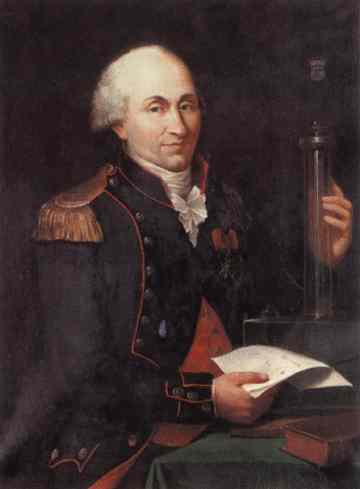<Back to Index>
- Physicist Charles-Augustin de Coulomb, 1736
- Author Harriet Beecher Stowe, 1811
- Revolutionary Ernesto "Che" Guevara, 1928

Charles-Augustin de Coulomb (14 June 1736 – 23 August 1806) was a French physicist. He is best known for developing Coulomb's law, the definition of the electrostatic force of attraction and repulsion. The SI unit of charge, the coulomb, was named after him.
Coulomb was born in Angoulême, France, to a well-to-do family. His father, Henri Coulomb, was inspector of the Royal Fields in Montpellier. His mother, Catherine Bajet, came from a wealthy family in the wool trade. When Coulomb was a boy, the family moved to Paris and there Coulomb studied at the prestigious Collège des Quatre-Nations. The courses he studied in mathematics there, under Pierre Charles Monnier, left him determined to pursue mathematics and similar subjects as a career. From 1757 to 1759 he joined his father's family in Montpellier and took part in the work of the academy of the city, directed by the mathematician Augustin Danyzy. With his father's approval, Coulomb returned to Paris in 1759 where he was successful in the entrance examination for the military school at Mézières.
After he left the school in 1761, Coloumb initially took part in the survey for the British coastal charts and was then sent on a mission to Martinique in 1764 to take part in the construction of the Fort Bourbon under the orders of the lieutenant-colonel of Rochemore, as the French colony was insulated in the middle of the English and Spanish possessions following the Seven Years' War. Coulomb spent eight years directing the work, contracting tropical fever. He carried out several experiments on the resistance of masonries and the behaviour of the walls of escarpe (supportings), which were inspired by the ideas of Pieter van Musschenbroek on friction.
Upon his return to France, with the rank of Captain, he was employed at La Rochelle, the Isle of Aix and Cherbourg. He discovered an inverse relationship of the force between electric charges and the square of its distance, later named after him as Coulomb's law.
In 1781, he was stationed permanently at Paris. On the outbreak of the Revolution in 1789, he resigned his appointment as intendant des eaux et fontaines and retired to a small estate which he possessed at Blois. He was recalled to Paris for a time in order to take part in the new determination of weights and measures, which had been decreed by the Revolutionary government. He became one of the first members of the National Institute and was appointed inspector of public instruction in 1802. His health was already very feeble and four years later he died in Paris.
Coulomb leaves a legacy as a pioneer in the field of geotechnical engineering for his contribution to retaining wall design. In 1784, his Recherches
théoriques et expérimentales sur la force de torsion et
sur l'élasticité des fils de metal (Theoretical
research and experimentation on torsion and the elasticity of metal
wire) appeared. This memoir contained the results of Coulomb's
experiments on the torsional force for metal wires. His general result is, It also contained a detailed description of different forms of his torsion balance. He used the instrument with great success for the experimental investigation of the distribution of charge on surfaces, of the laws of electrical and magnetic force and of the mathematical theory
of which he may also be regarded as the founder. In 1785, Coulomb
presented his three reports on Electricity and Magnetism. Four
subsequent reports were published in the following years. Coulomb
explained the laws of attraction and repulsion between electric charges
and magnetic poles, although he did not find any relationship between the two phenomena. He thought that the attraction and repulsion were due to different kinds of fluids.